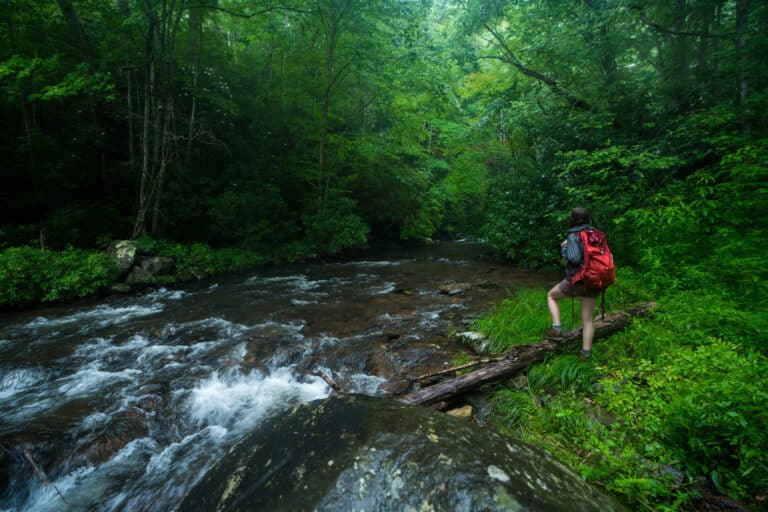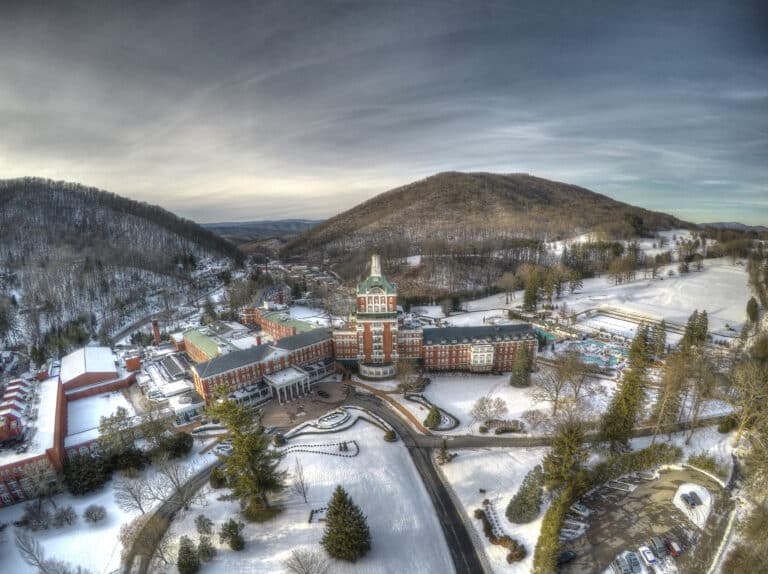Click here to view our criteria and rankings for all the schools covered.
BRO’S Honor Roll of the Region’s Greenest Colleges and Universities
We did our homework for this assignment. Blue Ridge Outdoors researched, interviewed, and examined all of the region’s colleges and universities to determine which schools are not just teaching about a better world but also are actually doing something about it. Over the past year, Blue Ridge Outdoors talked with students and administrators, conducted surveys, and investigated energy use on college campuses across the Southeast. Then we used strict criteria in nine categories to evaluate each school. Did your college or university make the grade?
BIG SCHOOLS
(Enrollment greater than 7,500)

1. Emory University Atlanta, Ga.
Atlanta’s Emory University hits all the high points when it comes to sustainability. Solar photovoltaic panels are scattered throughout the campus. The school was one of the early adopters of LEED certification for buildings and holds the distinction of having the first LEED-certified building in the Southeast as well as the first educational building certified under the LEED for Existing Buildings Program. It has a 55 percent recycling rate as well as a food composting program. But where the school really shines, and why it made the top of our list, is in its commitment to an all-encompassing sustainable education.
“Our greatest impact is our students,” says Ciannat Howett, director of sustainability initiatives for Emory.
Emory already features majors and minors in environmental studies. It will soon feature a minor specifically in sustainability. Recently, the MacArthur Foundation awarded a grant to Emory for the creation of a sustainable development graduate program that will partner it with Columbia University and the University of Florida, as well as schools in India, Australia, China, and Nigeria.
Environmental education at Emory starts from the moment students arrive on campus. Rainwater harvesting on dorm roofs is pumped via solar energy into the building to provide water for dual-flush toilets. The school’s restriction on the number of cars allowed on campus means students become familiar with alternative transportation — be it the school’s Cliff shuttle system (which runs entirely on alternative fuels), or its bike-sharing and Zipcar programs. The goal, Howett says, is to have students become so familiar with sustainability that it becomes a part of their normal lives even after they graduate.
“The most important impact we will have is in educating sustainability leaders for the future,” Howett says.
Emory is not content to rest on its present achievements, though. By 2015, the school plans to reduce its energy consumption by 25 percent from 2005 levels, obtain 75% of the food for its cafeterias and teaching hospital from local or sustainable sources, and divert 65% of its waste from landfills. Howett believes that students notice efforts such as this, and in an age where young people are more interested in sustainability than ever, schools such as Emory greatly benefit from being on the leading edge of the green movement.
“If you want to get the best and the brightest to come to your campus in this day, you are going to need to be showing your commitment to sustainability,” she adds.
Renewables 3
Energy Conservation 3
Food 5
Transportation 5
Green Building 5
Recycling 5
Program 4
Green Space 5
Outdoor Recreation 3
Best of the rest…
 2. Duke University Durham, N.C.
2. Duke University Durham, N.C.
GREEN: Commitment to carbon neutrality by 2024; 38 percent of food budget spent on local food; 26 buildings LEED-certified or in the process of being certified, including a LEED-Platinum dorm; recently signed a commitment to place 1,220 acres of the 8,000-acre Duke Forest in the North Carolina Registry of Natural Heritage Areas, which will prevent future development and invasive research.
NOT SO GREEN: Still burns coal in one of its two steam plants, but that plant only operates at peak times; the school is also exploring biomass as an alternative fuel source for plants.
Renewables 2
Energy Conservation 3
Food 4
Transportation 5
Green Building 5
Recycling 4
Program 5
Green Space 5
Outdoor Recreation 4
3. Georgia Institute of Technology Atlanta, Ga.
GREEN: Extensive research in solar energy, which includes two solar photovoltaic and one solar thermal system and a sixth place finish at the 2008 Solar Decathlon; offers more than 22 degree programs and 260 courses focusing on sustainability, and every student will take at least one course in sustainability before graduation; despite being an urban campus, contains 52 percent green space and 22 percent tree canopy, and was one of the first 10 schools to receive the Tree Campus USA award.
NOT SO GREEN: Waste diversion rate of only 35 percent, but the school has a long-term goal of becoming waste neutral.
Renewables 4
Energy Conservation 3
Food 4
Transportation 4
Green Building 5
Recycling 4
Program 5
Green Space 4
Outdoor Recreation 4

4. North Carolina State University Raleigh, N.C.
GREEN: In the bidding process to retrofit a natural gas steam plant as a heat production and energy cogeneration facility; Extensive alternative transportation options, including free campus and city buses, a bike-sharing program, alternative fuel stations, and showers and bike racks for cyclists; expanded sustainability course offerings, including concentrations and minors in environmental policy, agro-ecology and sustainable design.
NOT SO GREEN: Commitment to a minimum of LEED-Silver certification for all new construction and renovation projects, but no specific projects, either completed or under construction, mentioned; not as much protected space, but efforts are under way to preserve the 97-acre Lake Raleigh Woods.
Renewables 4
Energy Conservation 4
Food 4
Transportation 5
Green Building 3
Recycling 4
Program 5
Green Space 3
Outdoor Recreation 4
5. University of North Carolina Chapel Hill, N.C.
GREEN: Energy use has declined 8 percent per square foot since 2003; 16 LEED-acccredited professionals on staff; world-renowned Institute for the Environment and a sustainability center within the business school.
NOT SO GREEN: Coal-fired steam plant; only 21% of food purchased is local.
Renewables 2
Energy Conservation 5
Food 3
Transportation 5
Green Building 4
Recycling 4
Program 5
Green Space 5
Outdoor Recreation 3
6. Western Carolina University Cullowhee, N.C.
GREEN: Online ride share and bike share programs, in addition to free campus and city transit; Class I-II Tuckasegee river adjacent to campus; climbing club is largest student sports club.
NOT SO GREEN: No renewable energy programs; only 5 percent of campus food is local.
Renewables 2
Energy Conservation 4
Food 2
Transportation 5
Green Building 3
Recycling 4
Program 4
Green Space 4
Outdoor Recreation 5
7. Virginia Tech Blacksburg, Va.
GREEN: Transit system will soon introduce hybrid buses; car sharing program; local and organic sections at Owens Food Court; 12 buildings currently seeking LEED certification; Tree Campus USA award.
NOT SO GREEN: Coal-fired steam plant; no renewable energy.
Renewables 1
Energy Conservation 3
Food 4
Transportation 5
Green Building 4
Recycling 4
Program 4
Green Space 4
Outdoor Recreation 3
8. Appalachian State University Boone, N.C.
GREEN: 100 kilowatt wind turbine coming online in July; 66-acre nature preserve on campus; wilderness orientation program for incoming freshmen.
NOT SO GREEN: 1% of campus food is local or organic; renewable energy currently only contributes 0.02 percent to total energy needs.
Renewables 3
Energy Conservation 4
Food 2
Transportation 3
Green Building 3
Recycling 4
Program 4
Green Space 4
Outdoor Recreation 5
9. University of Virginia Charlottesville, Va.
GREEN: Student-run organic garden on campus; 50% recycling rate.
NOT SO GREEN: Coal-fired steam plant; no renewable energy.
Renewables 1
Energy Conservation 3
Food 3
Transportation 5
Green Building 4
Recycling 4
Program 4
Green Space 2
Outdoor Recreation 4
10. Radford University Radford, Va.
GREEN: All campus diesel vehicles use biodiesel; sustainability-themed residence hall floors.
NOT SO GREEN: No renewable energy; no formal policy to increase/protect campus green space.
Renewables 2
Energy Conservation 3
Food 3
Transportation 4
Green Building 4
Recycling 4
Program 2
Green Space 2
Outdoor Recreation 5
11. University of Georgia Athens, Ga.
GREEN: In past 15 years, added 46 acres of green space and removed 1.5 million square feet of asphalt; 25 environmental student organizations.
NOT SO GREEN: Coal-fired steam plant; not a significant buyer of local/organic food.
Renewables 1
Energy Conservation 3
Food 2
Transportation 4
Green Building 4
Recycling 4
Program 3
Green Space 4
Outdoor Recreation 4
12. University of North Carolina-Greensboro Greensboro, N.C.
GREEN: 40-acre Piney Lake Recreation Area; more than 100 courses with a sustainability component.
NOT SO GREEN: No renewable energy; no long-term plans to reduce energy consumption.
Renewables 2
Energy Conservation 2
Food 3
Transportation 4
Green Building 3
Recycling 4
Program 4
Green Space 3
Outdoor Recreation 4
SMALL SCHOOLS
(Enrollment less than 7,500)

1. University of North Carolina – Asheville Asheville, N.C. and Warren Wilson College Swannanoa, N.C.
Warren Wilson College is no stranger to sustainable schools lists, and it is able to consistently do so for one simple reason — sustainability is a part of all aspects of campus life and has been for years.
“Long before it was popular to be on board with the environment and sustainability, it was a practicing ethic of this college,” says Margo Flood, executive director of Warren Wilson’s Environmental Leadership Center. She is quick to add that this is said with the utmost humility, because, in her opinion, the school still has a long way to go to become truly sustainable.
But Warren Wilson also has a lot to be proud of. Its first environmental studies classes were offered not long after the first Earth Day, and today more than a quarter of the school’s students major in the subject. Its recycling program was launched in the mid-80s, and in 2008, Warren Wilson was named the top higher education recycling program in the nation by the National Wildlife Federation.
What Flood is most proud of, though, is the school’s recent commitment to making sustainable decisions in all aspects of the school’s operation, which Flood sees as fundamental to creating a truly green campus and a good example for its students.
“Here we are, educating young people to go forth and be leaders, and the greatest thing we can educate them in is how to make sustainable decisions,” Flood says.

But Warren Wilson is not limited to just things like LEED buildings (it has four with one more expecting certification soon) and carbon offsets (it purchases wind energy credits for 100 percent of its power needs). Outdoor Education is one of the school’s most popular majors, and its mountain biking team consistently finishes among the top 3 in the nation. The Swannanoa River also runs right through campus, providing students with nearby paddling.
Warren Wilson’s neighbor, the University of North Carolina at Asheville, has made itself a shining example of sustainability within the state’s university system. Like Warren Wilson, it features solar panels and geothermal systems throughout the campus, which have helped it lower its energy usage immensely. In fact, UNCA has the lowest energy consumption in BTUs per square foot of all 16 of UNC’s campuses and North Carolina state agencies.
On the academic side, UNCA’s environmental studies degree is its third most popular major, but that is only the beginning of its course offerings. The Food for Thought cluster of classes provides a multidisciplinary approach that looks at food from economic, biological, and sociological angles. On the research front is the school’s National Environmental Modeling and Analysis Center, which collaborates with groups such as National Oceanic and Atmospheric Administration, the U.S. Forest Service and the state of North Carolina for environmental research. Rather than work separately from each other, the operations and academic sides of the school work together to promote the overall sustainability of the university.

“What I find to be most powerful at [UNCA] is the spirit of collaboration that we have here,” says Edward Katz, associate provost and dean of university programs at UNCA.
The school also makes purchasing sustainable food a priority. Fifteen percent of the food used in its dining halls is organic and 7% is local. Last fiscal year, more than 990 tons of waste were recycled at the school. UNCA shares the basic belief with others on this list that sustainability must go beyond surface improvements.
“Sustainability is not something that you add to your process,” says Stephen Baxley, director of facilities management for UNCA. “It’s the way that you live.”
Renewables 5
Energy Conservation 5
Food 3
Transportation 3
Green Building 4
Recycling 5
Program 5
Green Space 3
Outdoor Recreation 5
Best of the rest…
3. Longwood University Farmville, Va.
GREEN: Biomass-fired steam plant and exploring cogeneration for the plant; three LEED-accredited professionals on staff, one LEED building constructed and one LEED renovation underway; alternative Spring Break this year will build trails at Cumberland Train State Park in Tennessee; campus master plan will increase campus green space from 42 percent to 46 percent by 2020.
NOT SO GREEN: No plans outside of current dining contract to increase amount of local food for dining services; lack of alternative transportation incentives outside of free local transit and 11 low-emission vehicle parking spaces at new auditorium.
Renewables 5
Energy Conservation 3
Food 3
Transportation 4
Green Building 5
Recycling 3
Program 3
Green Space 4
Outdoor Recreation 5

4. Berry College Rome, Ga.
GREEN: 26,000-acre wooded campus, including a 16,000-acre Wildlife Management Area and a reservoir that provides hiking and mountain biking trails, student campsites and other recreation opportunities; extensive building retrofits for efficiency; student-run campus garden.
NOT SO GREEN: No renewable energy.
Renewables 3
Energy Conservation 3
Food 3
Transportation 3
Green Building 4
Recycling 4
Program 4
Green Space 5
Outdoor Recreation 5
5. Furman University Greenville, S.C.
GREEN: Requires all students to take at least one environmental studies course; renewable energy sources include solar photovoltaic and solar thermal arrays and geothermal systems planned for campus apartments; quarter-acre, on-campus produce farm that sells at campus farmers’ market; restoring quality of Furman Lake.
NOT SO GREEN: On-campus hiking and biking trails but no other outdoor recreation opportunities; recycling program, but no long-term goals.
Renewables 3
Energy Conservation 3
Food 4
Transportation 4
Green Building 4
Recycling 4
Program 5
Green Space 4
Outdoor Recreation 2
6. Richmond University Richmond, Va.
GREEN: Free local transit passes and campus shuttle; bike sharing program; Earth Lodge environmental live-and-learn residence program; dual degree program with Duke University in environmental studies and forestry as well as its own environmental studies degree programs.
NOT SO GREEN: Coal-fired steam plant and no renewable energy, but is conducting feasibility studies for biomass power for steam plant as well as solar photovoltaic and geothermal systems.
Renewables 1
Energy Conservation 3
Food 3
Transportation 5
Green Building 4
Recycling 4
Program 5
Green Space 4
Outdoor Recreation 3
7. University of Mary Washington Fredericksburg, Va.
GREEN: Purchased 80% of its food from local/organic sources; 60% of campus is green space.
NOT SO GREEN: No renewable energy.
Renewables 1
Energy Conservation 4
Food 5
Transportation 3
Green Building 3
Recycling 4
Program 4
Green Space 4
Outdoor Recreation 3
8. Washington and Lee University Lexington, Va.
GREEN: Recent energy performance contract cut greenhouse emissions by 2,000 metric tons; plans to reduce BTU usage per square foot 25% by 2013; 1-acre campus garden that provides food for the needy; disc golf course.
NOT SO GREEN: No renewable energy; no alternative transportation programs outside of Saturday shuttle and bike share program at library.
Renewables 2
Energy Conservation 5
Food 4
Transportation 3
Green Building 3
Recycling 4
Program 4
Green Space 4
Outdoor Recreation 3
9. College of William and Mary Williamsburg, Va.
GREEN: Half of campus is protected green space; two lakes on campus for paddling; extensive energy conservation measures under way.
Renewables 2
Energy Conservation 3
Food 2
Transportation 3
Green Building 4
Recycling 2
Program 4
Green Space 5
Outdoor Recreation 4
10. Lynchburg College Lynchburg, Va.
GREEN: 470-acre Claytor Nature Center features hiking trails, campsites, a river, and an astronomical observatory; recently launched energy conservation initiative will reduce energy use by one-third and cut CO2 emissions by 5,438 metric tons annually.
NOT SO GREEN: No renewable energy.
Renewables 2
Energy Conservation 3
Food 2
Transportation 3
Green Building 2
Recycling 3
Program 4
Green Space 5
Outdoor Recreation 5
11. Wake Forest University Winston-Salem, N.C.
GREEN: Campus shuttle is a solar-electric hybrid; Zipcar program; 33 percent recycling rate; 80 courses focusing on sustainability.
NOT SO GREEN: No renewable energy; only 8 to 10 percent of campus food is local/organic, but a student-run campus garden does exist.
Renewables 2
Energy Conservation 4
Food 2
Transportation 5
Green Building 3
Recycling 4
Program 3
Green Space 3
Outdoor Recreation 3
COAL-FREE CAMPUSES
More than 60 schools nationwide still have on-campus power plants that burn coal, often to power their steam facilities. Steam plants typically are smaller than utility coal-fired plants, and they burn coal to boil water for heating and cooling rather than for electricity.
Even if schools don’t have their own power plant, all of the colleges and universities in our region are powered primarily by coal.
While many schools are ramping up sustainable measures such as switching to green cleaning products and adding recycling bins, these measures are often just token greenwashing. Energy use is the number-one focus for the Sierra Club’s Student Coalition. They are part of a network of grassroots college groups building student opposition to coal plants on a school-by-school basis.
“The biggest challenge is like in any political battle — it’s fighting the funding,” says Kim Teplitzky, coal campaign organizer for the Sierra Student Coalition. Grassroots student groups are often up against big coal companies who provide substantial donations to many colleges and universities.
But the momentum seems to be shifting. Several schools in the South with coal-fired plants, including Duke University and the University of Georgia, are exploring ways to retire their coal plants.
“Colleges and universities are model institutions for society,” says Teplitsky. “They must be the leaders in implementing sustainable and renewable energy solutions.”
Southeastern Schools with Coal-Fired Power Plants
University of Georgia
University of North Carolina
Duke University
Clemson University
Eastern Tennessee State University
Tennessee Tech
University of Tennessee
Vanderbilt University
Hampton University
Lynchburg College
Roanoke College
University of Richmond
University of Virginia
Virginia Tech
Eastern Kentucky University
Kentucky State University
Morehead State University
University of Kentucky
University of Louisvile
Western Kentucky University








